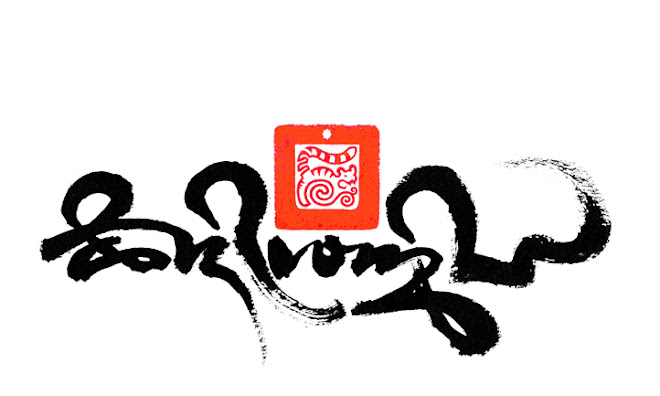 |
The 16th Karmapa, Rangjung Rigpe Dorje during the
Black Hat ceremony at Dagpo Kagyu Ling, France.
Photography by Peter Mannox (Tashi's father). |
The meaning of “Karma” is action or activity, and “Karmapa” means the one who does the activity. The activity here refers to the activity to benefit beings, and that is the main concern of the Buddhas in the ten directions and of the three times.
 |
"Karmapa Khyeno" Tibetan Uchen script,
ⓒ Tashi Mannox 2013 |
As to the origin of this title, it comes from a pure vision that the first Karmapa, Dusum Khyenpa, had when he was sixteen years old. As he first took the monastic vow, he had a vision that all of the Buddhas, Bodhisattvas, and the 100,000 Dakinis made a black hat out of their hair, and then offered it to him to wear. He was then consecrated or enthroned as the doer, the one who does the activities of all the Buddhas and Bodhisattvas. It was at that time that Dusum Khyenpa received the title “Karmapa”. Additionally, the name “Karmapa” does not necessarily refer to one particular individual. It can also be a general name for all Dorje Lopons – the Vajra Masters, or Vajra Acharyas - who do the activities of the Buddha. Therefore, it can be regarded as the general name for all great and genuine lamas. It is acceptable to call every lama “Karmapa”. Buddha once said, “When the Dharma is nearing extinction, I myself will come as Vajra Masters or Vajra Acharyas, and then do the activity of the Buddha.” What is the activity of the Buddha? It is to bring out the Buddha nature in people – the side of them that is positive, white, or light. To bring that out is to do the activity of the Buddhas. So therefore, when we talk about the “Karmapa” or say “Karmapa Khyeno”, it is also generally to bring out the positive action of the Buddhas in all sentient beings. Finally, in “Karmapa Khyeno”, “Khyeno” means “please think of me”. With this, we remember the lama again and again, constantly keeping in mind the positive qualities of the lama and praying to him or her. Milarepa once said, “When I am in a crowd, I call for my lama from my heart.” In the same way, you can evoke the lama, holding him or her in your heart. It is not necessary to say it aloud. But if you want to say it aloud, there is also nothing wrong with that.
from “17th Gyalwang Karmapa's Teachings “Living The Dharma” English Translator: Ringu Tulku Rinpoche at Tergar Monastery, Bodh Gaya, India. 1/12 ~ 1/14, 2009 http://www.kagyumonlam.org/English/Lectures/20090114_HHK_Teachings_Living_The_Dharma.html
Karmapa Khyeno !
Read more on Karmapa here.



Awesome! Thank you from Cliff in Cleveland
ReplyDeleteThis post resonated with me. Thank you for sharing.
ReplyDelete